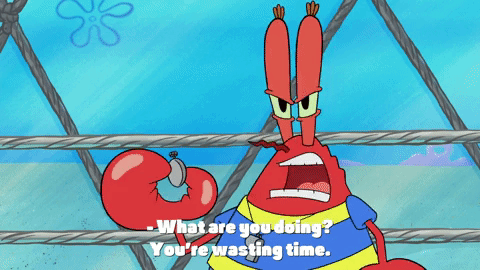Make the most of your job search.
We’ve been there.
The frantic late-night search sessions with a different job board open in every tab. Submitting your resumé to anything with the word “internship” in the title. Desperately trying to convince yourself you could totally spend 16 weeks planning events as a marketing intern, even though you’re studying child and youth care, because at least you’ll be able to add intern experience to your resumé.

We’ve been there. And, because we’ve been there, we don’t want you to make the same mistakes we did.
So, here are four common faux-pas you’ve likely made while searching for internships, and how to correct them, so your next job hunt can be mistake-free:
Mistake 1: You don’t know what you’re looking for
We know you want an internship really, really badly. But that doesn’t mean you should abandon your standards!
For one, having at least a general idea of what you want can help you sort through the endless online job postings and decide which placements are actually worth applying to. And, second, it’ll save you from being roped into an internship that’s all wrong for you or that’s completely unrelated to your career goals (or both).

How to fix it
Before you start out on your internship hunt, sit down with yourself and make a list of “must-haves” and “wants.” The former are — you guessed it — things an internship must have for you to apply to it. They’re your deal-breakers. The latter are things you’d like your internship to include; but they’re not deal-breakers.
Once you have your list, stick to it; don’t spend your time crafting an application for something that isn’t right for you. You may submit less applications overall — but the ones you do will be better quality and for positions that’ll truly benefit you.
Mistake 2: Your keywords are too narrow
You don’t want to be too broad with your internship search — but, on the other end of the spectrum, you don’t want to be too narrow. It’s a common misconception that your internship can only be exactly related to your program.

How to fix it
Broaden your horizons! Search for jobs in your program’s field but also in related ones and in encompassing disciplines. For example, if you’re studying graphic design, you could expand outwards and look for internships in advertising or media communications.
Mistake 3: You only search Indeed
Indeed, ZipRecruiter and Glassdoor Jobs can be great places to start narrowing down the kind of internship you want. However, mass job sites are designed to prioritize quantity over quality.
To illustrate, Indeed adds over 860,000 new job postings per day. That sounds like a great thing — but it could mean more work for you. There’s no way for the site to take your work style, must-haves or short- and long-term career goals into account — all you have to break up the noise are keywords and a location. Because of that, you’ll likely end up spending time sifting through irrelevant job postings that you could be spending applying to curated positions.

How to fix it
Use Indeed as a jumping-off point. Begin by searching the site for internships you think you’d be interested in, based on your list of must-haves and your field of interest, until you’ve pinpointed some specific job titles and/or keywords that seem generally in-line with your goals. Then, enter those titles into the “open jobs” section on the website of an organization you’d like to work for.
Alternatively, hit up Humber’s CareerConnect job board! It’s specifically designed with you in mind — it knows your program, campus, degree level and interests and it lets you search by job type, job function and industry. Plus, its career finder will show you job titles that suit your skillset and its resource library can help you make an application plan. Whether you’re looking for a full-time, part-time, contract, summer, volunteer and/or on-campus internship, CareerConnect is the place to go for student-friendly listings.
Also, never underestimate the power of networking.
Mistake 4: You don’t have a plan
If we were to summarize the internship hunt in a word, it would be, “overwhelming.” Like, you’ve got to fine-tune your resumé for each position you apply to, research each company and write a cover letter based on your research. Then, you’ve got to re-input your work history into the application website even though you’ve already submitted your resumé (seriously, why do they make us do that?) Then you have to repeat that process…however many times it takes.
Writing quality applications is time-consuming. Without a plan, it’s easy to overwork yourself and end up either producing subpar submissions or neglecting other responsibilities.

How to fix it
Set boundaries. Slot in a designated amount of time per day, or per week, to apply for internships. And, use that time wisely — develop a list of keywords to search, make your lists of must-haves and wants and research organizations you might want to work for.
In other words, don’t throw a million applications at the wall to see what sticks. Throw a couple of really good applications at carefully-selected walls because those are more likely to stick.
Mistake 5: You start looking too early — or too late
There’s a Goldilocks Zone for internship applications. Apply too early and companies might forget about you or turn you away completely since they’re not yet preparing for their next round of student hires. Apply too late and the position you’re vying for has probably already been snatched up.
How to fix it
Fine-tune your timing. Generally, companies advise beginning your internship search around four to six months before you’re looking to start. You can use the school year to measure — if you want an internship for the end of the semester, start your search at the beginning of it.

Don’t fret if you’ve made these mistakes before — we’ve been there, too.
And, go easy on yourself. Internship-hunting isn’t easy — if it were, there wouldn’t be so many guides for it. All you can do is give it your best shot and correct mistakes when they happen.
You got this.
Once you’ve sent your resume, you need to nail that follow-up email — here’s how.
Follow IGNITE on Facebook, Instagram and Twitter for all things student life.
